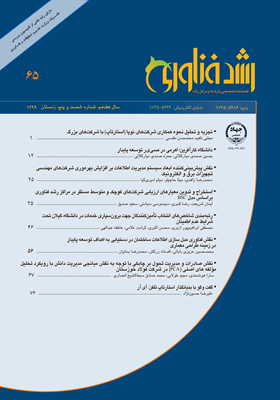نقش فناوری مدلسازی اطلاعات ساختمان در دستیابی به اهداف توسعهپایدار در زمینه طراحی معماری
محورهای موضوعی : مديريت تکنولوژي
محمدحسین عزیزی بابانی
1
,
افسانه زرکش
2
,
محمدرضا بمانیان
3
![]()
1 - دانشگاه تربیت مدرس
2 - دانشگاه تربیت مدرس
3 - دانشگاه تربیت مدرس
چکیده مقاله :
معضلات زیستمحیطی در کنار نابرابریهای اقتصادی و اجتماعی ناشی از گونههای نامتوازن توسعه که عمدتاً رهآورد انقلاب صنعتی هستند منجر به تشدید ظهور جنبشها و نظریاتی در نیمه دوم قرن بیستم با هدف دستیابی به توسعهای متوازن در زمینههای مختلف گردید که در این خصوص میتوان به نظریه توسعهپایدار اشاره نمود. دستیابی به اهداف توسعهپایدار در حیطه معماری مستلزم توجه به تمامی ابعاد زیستمحیطی، اقتصادی و اجتماعی است. بررسیهای انجامشده گواه آن است که معماری پایدار و بویژه جنبشهای متأخرتر مرتبط با آن که در حوزههای طراحی و ساخت از فناوریهای نوین بهره میبرند متناسب با چنین اهدافی هستند. در این میان فناوریهای طراحی رایانهای بهعنوان ابزاری تأثیرگذار در جهت تأمین اهداف پایداری به ایفای نقش پرداختهاند. در این پژوهش به بررسی میزان تأثیرگذاری کاربست فناوری مدلسازی اطلاعات ساختمان (BIM) در مراحل مختلف فرایند طراحی در جهت دستیابی به اهداف پایداری پرداخته شده است. روش پژوهش توصیفی تحلیلی است. در این راستا شاخصهای مربوط به کاربست BIM در تأمین پایداری از منابع کتابخانهای و مصاحبه با خبرگان و مطالعه نمونههای موردی که شامل ساختمانهای پایداری است که فرایند طراحی آنها بر پایه BIM بوده، استخراج گشتهاند. و با انجام تحلیل سلسله مراتبی بر مبنای معیارهای بدستآمده از مبانی نظری این نتیجه بدست آمده که عمده تأثیرگذاری BIM در راستای دستیابی به پایداری بواسطه امکان استفاده از تحلیلهای دینامیک در مراحل اولیه طراحی بهویژه تهیه طرح مفهومی و همچنین بسترسازی جهت برقراری تعاملات مؤثر میان مهندسین و سایر ذینفعان بوده است.
Environmental problems with economic and social inequalities caused by the industrial revolution led to intensifying the rise of movements and ideas in the second half of the 20th century to achieve a balanced development in different fields, which can be referred to as sustainable development theory. Achieving the goals of sustainable development in the field of architecture requires attention to all environmental, economic, and social aspects. Studies have shown that sustainable architecture, especially later-related movements, which utilize modern technologies in design and construction fields, are more suited to such goals. In this regard, computer-based design technologies, as effective instruments, played a significant role in achieving sustainability goals. This research investigates the amount of the effects of building information modeling (BIM) applications in different stages of the design process on achieving sustainability goals. The research method is descriptive-analytic. So indicators related to the use of BIM in sustainability achievement were collected through the library sources and case studies that contain sustainable buildings, which were designed using BIM applications. Then, by performing a hierarchical analysis based on the criteria derived from theoretical foundations, the authors concluded that the major BIM effects in achieving sustainability are due to the possibility of using dynamic analysis in the early stages of the design process, particularly the conceptual design stage as well as the establishment of effective interactions between engineers and other stakeholders.
